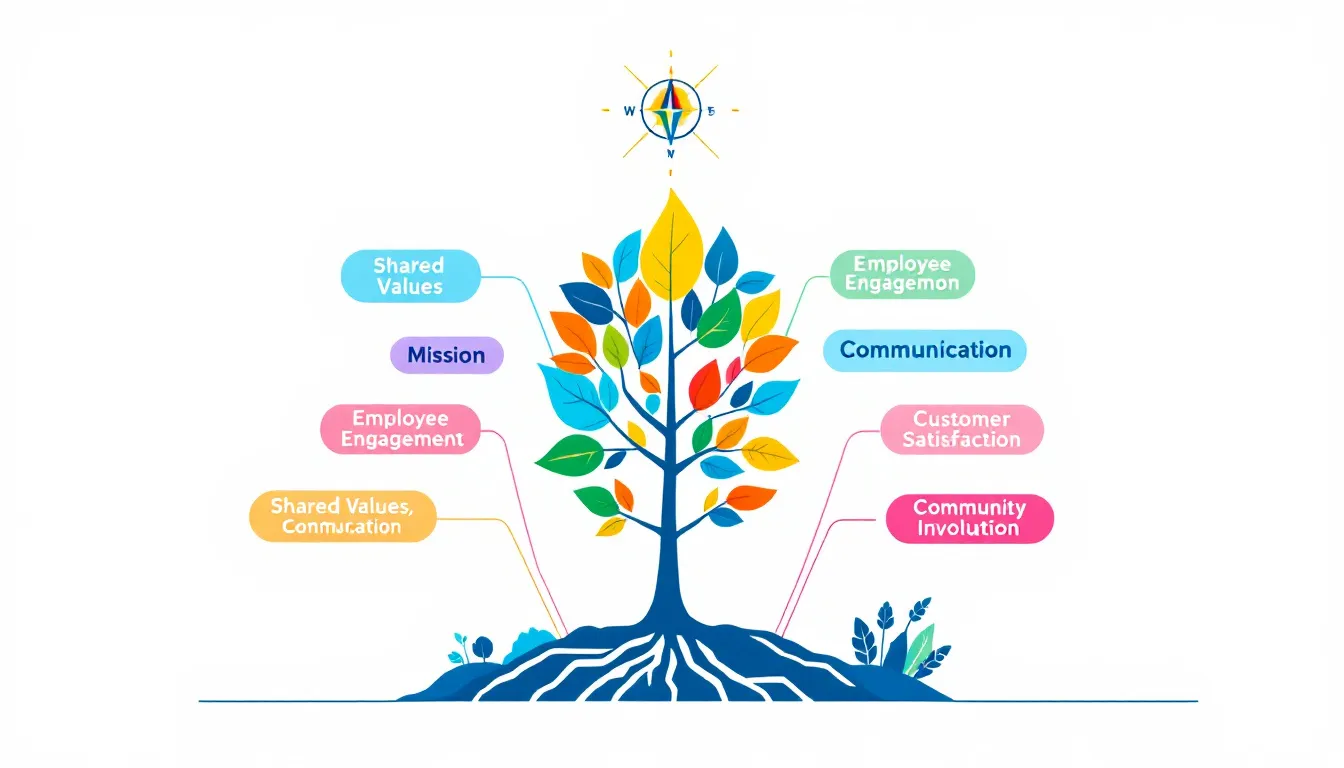Define Corporate Culture: The Essential Guide for 2025

Corporate culture is the shared values, beliefs, and behaviors that shape how a company runs. It impacts everything from employee interactions to business outcomes. In this guide, we’ll define corporate culture, identify its key components, and explain its importance.
Key Takeaways
- Corporate culture shapes business performance through shared values and beliefs, impacting operations and employee behavior.
- The four main types of corporate cultures—clan, adhocracy, market, and hierarchy—each present unique benefits and challenges suitable for different organizational needs.
- A strong corporate culture fosters employee satisfaction and retention, while alignment with company values and effective leadership are essential for sustaining a positive work environment.
Understanding Corporate Culture

Corporate culture acts as the unseen foundation for all elements of business performance. It significantly influences a company’s operations. Shared values, beliefs, and behaviors shape company operations. This culture is not just about formal policies but also includes the unwritten rules and collective behaviors that define an organization’s day-to-day functioning.
The perception of an organization’s culture is often influenced by both internal and external factors. Internal factors include the company’s leadership values and workplace expectations, while external factors can range from geographic values to industry standards. These elements collectively shape the corporate culture, creating a unique environment that can either drive or hinder the company’s success.
At its core, corporate culture is articulated through mission statements and vision documents, which outline the organization’s culture and set the tone for employee behavior. This consideration is vital for any business, particularly during its formative stages. For both startups and established enterprises, understanding and defining corporate culture is the first step towards building a cohesive and successful organization.
Key Components of Corporate Culture
Core values and vision form the essence of corporate culture, guiding employee behavior and decision-making. Often, core values are condensed into two or three words like integrity, innovation, or customer-centricity, representing the company’s core values. To ensure alignment between the company’s cultural values and operations, these core values must reflect in the corporate culture.
Corporate culture is defined by vision, values, practices, and the company’s culture and organizational narrative, including company vision. These elements include the definition corporate culture:
- company history
- brand
- code of conduct
- value proposition
- organizational behavior
- communication style
Together, they create a cohesive framework influencing how the employee contributes to interactions and work approach in a collaborative work environment.
Additionally, the physical environment, HR practices, staff work habits, and hierarchy play significant roles in shaping corporate culture. Innovation, collaboration, competition, community involvement, and social engagement further shape the cultural landscape within the business environment. These elements collectively shape the interaction patterns between management and employees, ultimately influencing how the organization approaches external business relationships.
The Importance of Corporate Culture

Corporate culture refers to a critical factor in achieving organizational success. Alignment with broader culture typically leads to greater organizational success. A strong corporate culture shapes employee behavior, attitudes, and interactions, resulting in improved satisfaction and productivity.
Well-defined corporate cultures often lead to enhanced overall business performance. A supportive work environment driven by positive workplace culture can enhance employee retention. Companies with strong corporate cultures often see increased employee health, happiness, and productivity, contributing to overall success.
Empowering employees fosters trust and satisfaction, enhancing retention and performance. Successful corporate cultures reflect a commitment to quality and excellence, enhancing the organization’s reputation. Trust and open communication are key to resilient corporate cultures, contributing to positive dynamics and higher returns.
Types of Corporate Cultures
Understanding different corporate culture types helps organizations choose one that best aligns with their values and goals. The four main types of corporate cultures are clan, adhocracy, market, and hierarchy. Each culture offers unique benefits and challenges, and selecting the right one depends on factors like the company’s industry, size, values, goals, and vision.
Clan culture works well in small to medium-sized businesses and family-owned companies, emphasizing strong interpersonal relationships. Adhocracy culture thrives in dynamic environments, fostering innovation, risk-taking, and a distinctive culture.
Market culture is characterized by a focus on competition and performance, often creating a high-pressure environment. Hierarchy culture, on the other hand, focuses on stability and efficiency through a formal structure and clear chain of command.
Clan Culture
Clan culture benefits small to medium-sized businesses by emphasizing strong interpersonal relationships. This culture fosters a collaborative environment where employees feel part of a family. The emphasis on mentorship, teamwork, and shared purpose creates a supportive atmosphere encouraging professional growth and loyalty.
Clan culture values community involvement and prioritizes employee well-being. This approach enhances job satisfaction and boosts productivity. Employees in a clan culture feel valued and motivated, contributing to a positive work environment and long-term success. Clan cultures foster a sense of belonging and collaboration.
Adhocracy Culture
Adhocracy culture emphasizes flexibility, open management, and innovation. Companies with this culture encourage engagement and innovative ideas. The focus is on innovation and risk-taking, with teams structured as small squads where leadership roles are determined by members.
This entrepreneurial atmosphere suits industries requiring constant innovation and creativity. Adhocracy culture thrives in dynamic environments, driven by aspirational goals and visionary objectives.
While it promotes innovation, it requires careful management to balance risks and support the team.
Market Culture
Market culture focuses on competition, performance over process, and a demanding, fast-paced environment. This culture often creates a high-pressure environment, emphasizing results and achievements. Industries like the financial sector, hedge funds, and private equity firms in a particular industry typically exhibit market cultures.
In a market culture, success is measured by competitive advantage and financial success and financial performance. Employees are motivated by targets, with a strong emphasis on meeting deadlines and achieving goals. While this approach can drive business success and a company’s success, it can also lead to high stress levels and burnout if not managed carefully, as illustrated by the competing values framework. Business leaders must be aware of these dynamics to foster a healthy work environment.
Hierarchy Culture
Hierarchy culture features a formal structure and clear chain of command, focusing on stability and efficiency. Core values revolve around structure, clear roles, established procedures, and an emphasis on efficiency and stability. Companies like Ford Motor Company exemplify this culture with their top-down leadership approach and centralized decision-making.
This culture suits organizations prioritizing consistency, reliability, and predictability. Employees in a hierarchy culture understand their roles and responsibilities, and there is a strong focus on following established procedures, contributing to a great business culture.
While it creates a stable environment, it may stifle creativity and limit innovation if not balanced with opportunities for employee input and growth.
How to Foster a Positive Corporate Culture

Core values serve as the foundation for all organizational actions. Developing these values should involve genuine input rather than just corporate jargon to resonate with employees. Effective communication ensures alignment on the company’s values, mission, and vision, fostering a positive work environment.
A strict zero-tolerance policy on harassment supports a safe and open environment for discussions. An open floor plan with flexible seating fosters collaboration, making employees feel more connected and engaged. Anonymous surveys, informal discussions, and company-wide meetings can gather employee feedback on company culture.
Companies can adjust their culture based on employee feedback by modifying work processes. A good corporate culture features professional growth, collaboration, leadership recognition, and common purpose. Organizing team events and in-person socials strengthens collaboration, especially in a hybrid work model. Emphasizing flexibility and work-life balance lowers employee turnover.
Real-World Examples of Successful Corporate Cultures

SquareSpace’s flat organizational structure enhances morale by promoting open communication and direct access to management. This fosters a collaborative culture where employees feel valued and empowered to share ideas.
Adobe’s culture encourages creativity by avoiding micromanagement and promoting trust and independence, aligning with an open management philosophy.
REI connects employees to its mission by involving them in outdoor initiatives and promoting environmental stewardship. This connection to core values enhances employee engagement and satisfaction, leading to more engaged employees.
Warby Parker fosters strong culture through teams that plan engaging events and activities. These activities build a sense of community and belonging.
Southwest Airlines empowers employees by promoting a unified team goal and encouraging extra effort for customer satisfaction.
Chevron prioritizes employee welfare, emphasizing safety and support among colleagues, distinguishing itself from competitors. These examples highlight the importance of aligning corporate culture with company values for organizational success.
Challenges in Developing Corporate Culture
As companies grow, they risk losing their successful culture, creating tensions between old and new hires. Corporate culture’s fragility means it can be lost due to rapid hiring, management changes, or mergers. Regular check-ins and discussions with employees enhance understanding and effectiveness of the culture.
A toxic work culture is characterized by a lack of motivation, no incentives, and poor business strategies, leading to unproductive employees. Negative factors like bullying, discrimination, and poor infrastructure can significantly detract from a positive working environment. A toxic culture, along with poor work-life balance, with unrealistic deadlines and unpaid overtime, leads to high turnover.
To reduce turnover, companies should provide high-quality training, tools, and development opportunities. Ongoing assessment and adaptation of corporate culture are necessary to remain effective. Employee engagement surveys are invaluable for gaining insights and measuring culture effectiveness. Leaders’ reactions during crises significantly influence organizational culture and employee morale.
The Role of Leadership in Shaping Corporate Culture
Leadership commitment to corporate values fosters a positive workplace culture. Effective leadership that fosters trust and open communication enhances employee retention. Clearly communicating the company’s vision ensures alignment and motivation among employees.
Leaders shape corporate culture by implementing policies, crafting recruitment strategies, and modeling desired behaviors. They establish the company’s mission, values, and vision. These elements form the foundation for corporate culture. Collaboration among leaders, stakeholders, and HR teams is required to establish a healthy corporate culture.
To support a culture of innovation, leaders must implement it in practice, not just discuss it. A strong understanding of business principles and organizational behavior is important for leaders shaping corporate culture. By committing to core values, leaders create a cohesive and motivated workforce driving organizational success.
The Impact of Corporate Culture on Employee Satisfaction
A strong corporate culture boosts employee job satisfaction by making them feel valued and part of a team. Employees who perceive a supportive culture are more likely to be engaged and stay with the company. Leaders with distinctive cultures are 80% more likely to report employee satisfaction. Strong cultures are essential for fostering these positive outcomes.
Promoting diversity and inclusivity helps create a more welcoming work environment for individuals from various backgrounds. Encouraging employees to share their ideas fosters a sense of value and belonging within the organization. Transparency and open communication are crucial in building trust between management and employees.
A healthy corporate culture increases productivity among employees and fosters a healthy culture, contributing to a positive company culture.
The Future of Corporate Culture

Corporate culture is dynamic. It changes in reaction to leadership styles, market trends, and societal shifts. As remote work becomes more prevalent, it is reshaping corporate culture by increasing flexibility and altering how teams collaborate. While this shift offers numerous benefits, it also poses challenges, such as hindering informal communication, which is essential for problem-solving and brainstorming.
Organizations are increasingly prioritizing diversity and inclusion practices to create more equitable work environments. Such organizations create a culture that embraces mistakes as learning opportunities, which is essential for fostering innovation.
Continuous learning initiatives are becoming crucial for businesses to keep employees engaged and adaptable to change. As we move forward, the ability of a corporate culture to adapt and evolve will be key to maintaining a competitive edge and achieving long-term success.
Summary
Corporate culture is the heartbeat of any organization, influencing everything from employee satisfaction to overall business performance. By understanding its key components, the importance of aligning it with broader societal values, and the different types of corporate cultures, companies can create a work environment that fosters growth, innovation, and success. Leadership plays a pivotal role in shaping and maintaining this culture, ensuring that it evolves with changing times and market trends.
In conclusion, a strong corporate culture is not just a strategic advantage; it’s a necessity for organizational success in 2025 and beyond. By fostering a positive, inclusive, and adaptable culture, companies can achieve higher employee engagement, satisfaction, and productivity, ultimately driving business success. The journey to cultivating a thriving corporate culture is ongoing, but with the right approach and commitment, the rewards are immeasurable.
FAQs
- What is corporate culture?
Corporate culture encompasses the shared values, beliefs, and behaviors that influence a company's operations and overall work environment. It plays a crucial role in shaping employee engagement and organizational success.
- How can companies maintain their corporate culture during growth?
To effectively maintain corporate culture during growth, companies should implement regular check-ins and discussions with employees to ensure ongoing assessment and adaptation of their culture. This proactive approach fosters engagement and alignment amid change.
- What role do leaders play in shaping corporate culture?
Leaders are instrumental in shaping corporate culture by implementing policies, modeling desired behaviors, and establishing the mission, values, and vision of the organization. Their actions and decisions directly influence the workplace environment and employee engagement.
- How does a strong corporate culture impact employee satisfaction?
A strong corporate culture enhances employee satisfaction by fostering a sense of belonging, promoting inclusivity, and encouraging open communication. This environment makes employees feel valued and engaged in their work.
You may also like
Unique spaces for your next offsite
Find distinctive venues for your upcoming corporate retreat.
Stay Updated with Our Insights
Get exclusive content and valuable updates directly to you.







